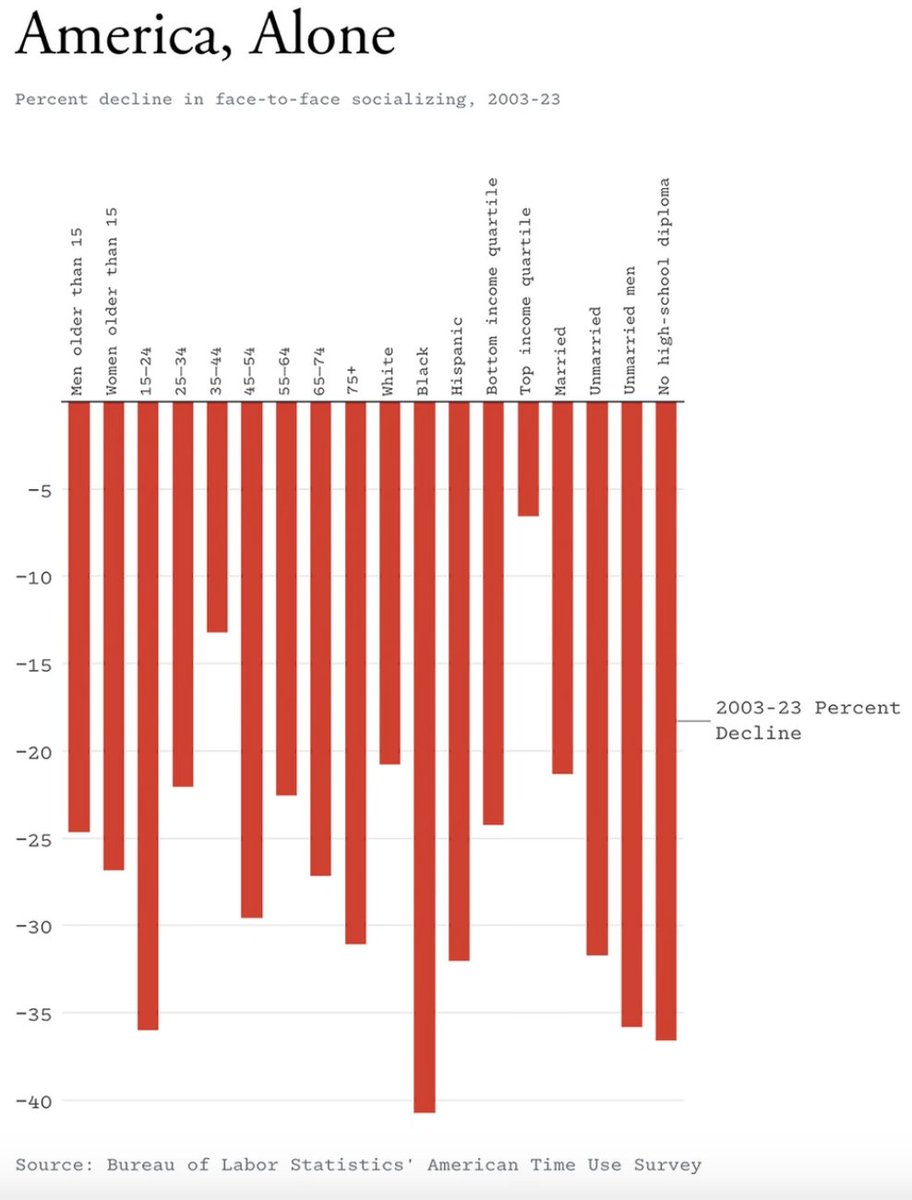
Jackson Steger
@JacksonSteger
Followers
1K
Following
3K
Statuses
2K
Founding Director @ The Network School
Singapore + Malaysia
Joined March 2017
@dagelf I did hand over clients to other competent editors :) DreamFrame was very profitable and made 16.5 grand for every $1,000 spent.
0
0
2
RT @ErikVoorhees: If you want to use DeepSeek but don't want all your convos going to the CCP, use All convos are…
0
473
0
RT @UrbanCourtyard: When LA is ready to rebuild, it should consider framing city blocks with stacked units, joined wall to wall, and built…
0
359
0
@DKThomp The three tiers of human-centric development we can build to help address these kinds of antisocial dilemmas:
Courtyards, campuses, cities. The three development tiers for building a better future. Each scales in funding, design, and regulatory complexity: Courtyards ($1-10M): Intimate communities of 15-20 adults and children, perfect for fostering deep connections among friends and family. These "supernuclear" groups can share spaces like kitchens, gyms, and gardens. Courtyards integrate well into neighborhoods and can evolve from a cluster of existing properties with local regulatory approval (e.g., Radish in Oakland). Campuses ($10-100M): Planned, self-sustaining hubs for 100-1,000 residents, featuring shops, restaurants, and parks. They are often multigenerational, car-free, and secure. They usually require re-zoning and broad local support to realize their vision (e.g., Culdesac in Tempe). Cities ($10B+): Large-scale, dynamic urban environments for 10,000+ residents, featuring robust market economies, transit systems, and cultural landmarks. Cities demand partnerships with government or major institutions to navigate complex infrastructure challenges (e.g., California Forever in Solano County).
0
0
3
We spend much more time at home - 99 more minutes per day compared to 2003. We need to redesign what home even is to address some of the problems that Derek identifies here.
I wrote the cover story of the February issue of The Atlantic. It builds on a lot of reporting I did throughout 2024, and I'm really proud of it. It’s called: THE ANTI-SOCIAL CENTURY The thesis: Rising solitude is the most important social fact in American life today. The historic amounts of time that Americans spend alone and in their homes is reshaping the consumer economy—from dining to entertainment to delivery—warping our politics, alienating us from the realities of our neighbors and villages, and changing our very personalities. Here are the basic facts: 1. In the last few years, in-person socialization has declined, for every demographic group, to its lowest point on record 2. The typical American is now alone more than in any period where we have decent data, going back to at least 1965 3. Americans now spend an extra 99 minutes in their homes compared to 2003—a trend that crept up slowly before the pandemic, before exploding and remaining at a seriously elevated level. As Princeton’s Patrick Sharkey wrote in a 2024 paper, the homebound trend isn't just about remote work. Homebound life has “risen for every subset of the population and for virtually all activities” from eating to praying. 4. America's social depression is far-reaching. The share of adults having dinner or drinks with friends on any given night has declined by more than 30% in the past 20 years. The share of boys and girls who say they meet up with friends almost daily outside school hours has declined by nearly 50%. I don’t think these trends are simple. In many cases, they’re not even simply bad. (Ordering delivery: totally fine! Eating more meals alone, year after year after year: not so great!) But to see these trends—and their effects on American society—more clearly, I thought this phenomenon needed an anchoring, a naming, a media artifact for people to talk about, even if only to point out that I’m wrong. So, I wrote this.
0
2
2
Courtyards, campuses, cities. The three development tiers for building a better future. Each scales in funding, design, and regulatory complexity: Courtyards ($1-10M): Intimate communities of 15-20 adults and children, perfect for fostering deep connections among friends and family. These "supernuclear" groups can share spaces like kitchens, gyms, and gardens. Courtyards integrate well into neighborhoods and can evolve from a cluster of existing properties with local regulatory approval (e.g., Radish in Oakland). Campuses ($10-100M): Planned, self-sustaining hubs for 100-1,000 residents, featuring shops, restaurants, and parks. They are often multigenerational, car-free, and secure. They usually require re-zoning and broad local support to realize their vision (e.g., Culdesac in Tempe). Cities ($10B+): Large-scale, dynamic urban environments for 10,000+ residents, featuring robust market economies, transit systems, and cultural landmarks. Cities demand partnerships with government or major institutions to navigate complex infrastructure challenges (e.g., California Forever in Solano County).
1
3
24
RT @balajis: It flew under the radar, but China is already opening up visas for tourism (on the mainland) and talent (via Hong Kong). And…
0
34
0
RT @demystifysci: how do you feel about a future where you live in a walkable community with a thousand ppl who share your core interests?
0
2
0
I lived in @MrBeast 's makeshift city while I competed for $5 million as part of the largest game show in history. While I didn’t win the grand prize, I became convinced that creators are natural candidates to lead massive long-term living communities. Let me explain: MY BEAST CITY EXPERIENCE Beast City was complete with sports facilities, a five-story tower, a cafe, cabin-style housing for 500, and a college-style quad. Living in Beast City felt less like a high-stakes game and more like a fully-realized experimental society. It was clearly designed with communal purpose in mind - sleeping quarters were positioned along the edges, while common gathering spaces occupied the center. This layout encouraged natural interactions, chance meetings, and shared moments that felt organic, not forced. Connections formed while we ate breakfast, strategized in small groups, or played sports in between official challenges. While viewers at home watching Beast Games will remember the psychological twists, the monster trucks, and the private islands, the most enduring legacy of Beast City for the bulk of its residents will be the bonds we formed with other contestants in this Nuketown lookalike. As many would remark on Instagram or in groupchats afterwards “other people just won’t understand what it was like.” The bubble we lived in helped us become friends faster. Most folks there shared both 1) a common appreciation for Mr. Beast’s content and 2) a distinct experience participating in the games. The experience helped reinforce a hypothesis of mine: creators are extremely well positioned to lead IRL experiences that foster organic connection, make money, and help address a loneliness crisis. CREATORS SHOULD CREATE THEMED OVERNIGHT IRL EXPERIENCES 1 in 5 US adults say they feel lonely every day. This is partially because of the decline of our in-person communities. Jobs are increasingly remote. School is online. Dating is in the DMs. Our generation barely goes to church any more, but we do tune in to watch our favorite creators every week. Creators have the distribution and loyalty to create themed IRL experiences and fill them with their fans. This advantage should not be overlooked. Elsewhere on the internet, coliving communities and startup cities attempting to host IRL experiences struggle to aggregate demand. Creators don’t have that challenge. To some extent, creators already host meet ups. @Jesser hosts basketball tournaments. @alexandrabotez and @itsandreabotez hosted an overnight chess camp. I predict that these creator-led living experiences will get longer and support more people. It’s now very feasible that 1,000 people who follow a certain creator online could live in the same place for a whole year. @balajis has a large audience on X where he also writes extensively about tech and Network States. A single tweet he wrote in August about a three month “Network School” pop-up (more on that in another forthcoming post) generated so much demand that we filled the first cohort of 150 people instantly and built a waitlist of ~5,000 people with no other marketing. Large creators will follow suit to host IRL longterm living experiences because it can be very profitable (and fun!). If creators develop/rent a campus where housing units cost them $250-1,000/month, they can easily charge $2-4,000/month by including basic shared amenities and themed programming. Dedicated fans will pay the premium to live near a community of like-minded folks. That margin is a great business model, and I can think of a few obvious ways this could happen soon: 1) I imagine that @bryan_johnson will build a longevity-focused living community that prioritizes great sleep conditions and healthy foods. 2) Video game creators will might creating the ideal configuration for gaming with each other with e-sports arenas and gigabit internet connections. 3) Musicians can host songwriting camps and longer-term housing organized around recording studios so that they can make songs whenever genius strikes. We humans are happiest surrounded by people we admire or love. YouTubers and other creators with large, engaged audiences are best positioned to use their internet audiences to aggregate demand into themed massive living experiences that will profitably help participants feel the same belonging we all crave. If you’re a creator hoping to host a pop up city experience, let me know how I can help.
83
30
507













